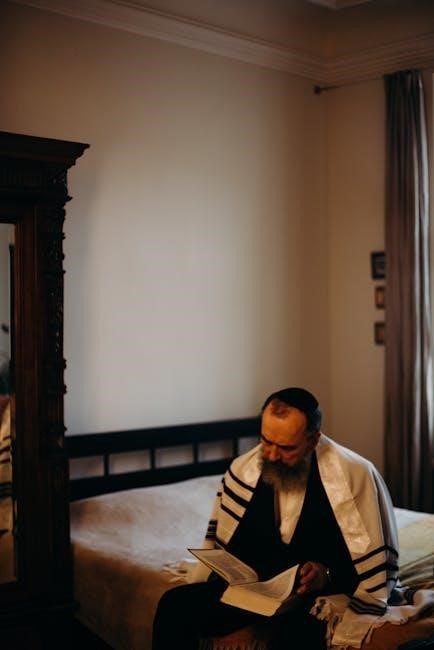
Shabbat prayers are a sacred ritual, creating a spiritual connection and fostering community․ They consist of specific blessings and recitations, guiding believers through a meaningful observance of the Sabbath․
Overview of Shabbat and Its Significance
Shabbat, the Jewish Sabbath, is a day of rest and spiritual renewal, observed from Friday evening to Saturday evening․ Rooted in the Torah, it commemorates God’s rest after creating the world and is a cornerstone of Jewish tradition․ Shabbat is a time to disconnect from daily routines and reconnect with family, community, and faith․ Central to its observance are rituals like lighting candles, reciting blessings, and engaging in prayer services․ These practices foster a sense of sacred time and space, emphasizing the importance of mindfulness and gratitude․ Shabbat is not just a day of rest but a celebration of life, faith, and the enduring covenant between God and the Jewish people, making it a vital part of Jewish identity and heritage․
The Importance of Prayer in Shabbat Observance
Prayer is central to Shabbat observance, serving as a bridge between the mundane and the sacred․ It marks the transition from the weekday routine to the holiness of Shabbat, creating a spiritual framework for rest and reflection․ Through prayers like Maariv on Friday evening and Shacharit on Saturday morning, individuals connect with God and the community, expressing gratitude for creation and the gift of Shabbat․ These prayers also foster mindfulness, encouraging believers to pause and appreciate the beauty of the world․ The recitation of blessings over wine and challah further sanctifies the day, infusing everyday acts with spiritual significance․ Prayer on Shabbat is not just a ritual but a way to nurture the soul and strengthen faith, making it an essential part of Jewish practice and identity․

Key Prayers and Blessings for Shabbat
Shabbat prayers include key blessings like the candle lighting, Kiddush, and Shema, each serving to sanctify the day and deepen spiritual connection․
The Shabbat Candle Blessing
The Shabbat candle blessing is a cherished ritual, marking the transition into the sacred day of rest․ It is recited after lighting the candles, typically by the woman of the household, though anyone can participate․ The blessing expresses gratitude for the commandment to kindle the Sabbath lights, symbolizing peace, warmth, and spiritual illumination․ The Hebrew text, “Baruch atah, Adonai Eloheinu, melech ha’olam, asher kid’shanu b’mitzvotav v’tzivanu l’hadlik ner shel Shabbat,” translates to a prayer of praise for the divine commandment․ This act not only honors Shabbat but also fosters a sense of unity and tranquility within the home․
The candles remind us to pause, reflect, and embrace the beauty of Shabbat․
Kiddush: The Sanctification of Shabbat
Kiddush, the sanctification of Shabbat, is a central ritual performed on Friday evening and Saturday morning․ It involves reciting a blessing over a cup of wine, symbolizing the separation of the sacred day from the mundane week․ The prayer, rooted in biblical commandments, expresses gratitude for the gift of Shabbat and its spiritual renewal․ The Kiddush text, often included in Shabbat prayer PDF guides, varies slightly between the evening and morning services but maintains its core purpose of honoring the Sabbath․ This ritual is typically led by the head of the household and is followed by the sharing of the wine, reinforcing unity and joy within the family and community․
Kiddush serves as a beautiful reminder of Shabbat’s holiness and its transformative power․
The Shema and Its Significance in Shabbat Services
The Shema is a foundational Jewish prayer, declaring the unity and sovereignty of God, and it holds profound significance in Shabbat services․ Recited during both the evening and morning prayers, it serves as a declaration of faith and loyalty to God․ The Shema is central to Jewish worship, emphasizing the obligation to love and serve God with all one’s heart, soul, and might․ On Shabbat, its recitation is particularly meaningful, as it reinforces the day’s sacredness and the community’s collective commitment to spiritual renewal․ The prayer’s rhythmic and auditory qualities create a sense of unity among worshippers, while its text reminds them of their covenantal relationship with God․ The Shema thus becomes a powerful expression of faith and connection during Shabbat observance․
Its inclusion in Shabbat prayer PDF guides ensures accessibility for all participants․

Structure of Shabbat Prayer Services
Shabbat prayer services include Maariv, Shacharit, Musaf, and Mincha, each with unique rituals and prayers․ These services create a structured framework for spiritual reflection and communal worship․
Prayer guides like Shabbat prayer PDFs outline the order and content, ensuring meaningful participation for all․

Maariv: The Evening Prayer Service
Maariv, the evening prayer service, marks the beginning of Shabbat․ It typically takes place at sunset on Friday and sets a peaceful tone for the Sabbath․ The service includes the recitation of the Shema, a central prayer in Judaism, and the Amidah, a silent prayer of devotion․ Maariv also features the recitation of hymns and blessings, such as “Lecha Dodi,” which welcomes the Sabbath as a bride․ The service is followed by Kiddush, the sanctification of Shabbat over wine․ Many communities use Shabbat prayer PDF guides to ensure participants can follow the order of prayers and understand their significance․ These guides often include translations and explanations, making the service accessible to all․ The Maariv service serves as a beautiful transition from the weekday to the sacred rest of Shabbat․
Shacharit: The Morning Prayer Service
Shacharit, the morning prayer service, is a central part of Shabbat observance; It begins with the recitation of the Shema, affirming the unity of God, and includes the Amidah, a standing prayer of praise and supplication․ The service also features the Torah reading, where portions from the weekly parasha are recited․ Many communities incorporate uplifting melodies and hymns, such as “Nishmat Kol Chai,” to enhance the spiritual atmosphere․ Shabbat prayer PDF guides often include the full text of Shacharit, along with translations and commentary, helping participants engage deeply with the prayers․ The service culminates with the Mussaf service, which reflects the additional offerings of the Temple era․ Shacharit serves as a joyful and reflective start to the Shabbat day, fostering connection and gratitude․

Musaf: The Additional Service
Musaf, the additional prayer service, is recited on Shabbat following Shacharit․ It originates from the additional sacrifices offered in the Temple on Shabbat․ The service includes the Amidah, which is recited silently and then repeated by the cantor․ Musaf highlights the uniqueness of Shabbat, with prayers focusing on its holiness and the rest it provides․ The service also includes the “Kedushah” and “Modim” sections, emphasizing gratitude and divine sovereignty․ Many Shabbat prayer PDF guides provide the full text of Musaf, including the “Atah Echad” and “Cantor’s Repetition” sections․ These resources help participants follow the service and understand its historical and spiritual significance․ Musaf concludes with “Aleinu” and the Torah reading, enriching the Shabbat experience with reflection and joy;
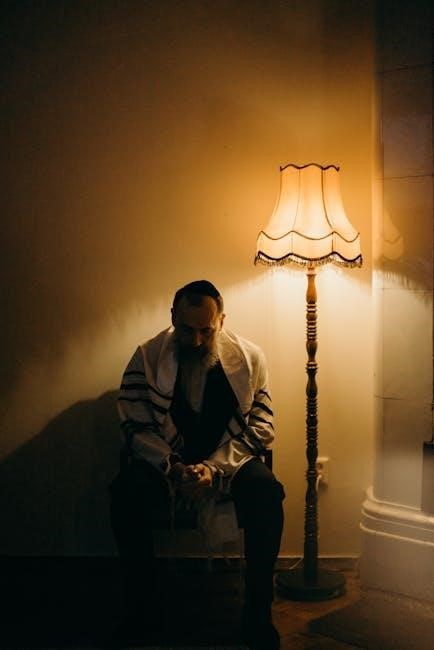
Mincha: The Afternoon Prayer Service
Mincha, the afternoon prayer service, is recited on Shabbat towards sunset, marking the transition from the day of rest to the evening․ This service is shorter than Shacharit or Maariv but retains key elements, such as the Amidah and the recitation of the Shema․ The Amidah for Mincha is similar to the weekday version but includes Shabbat-specific praises․ Many Shabbat prayer PDF guides include the Mincha service, offering translations and explanations to enhance understanding․ The service also features a brief Torah reading, adding to its spiritual depth․
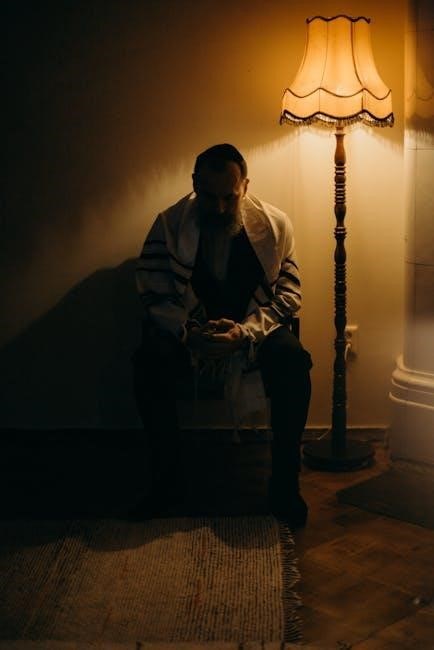
Mincha concludes with the “Aleinu” prayer, expressing hope for unity and divine sovereignty․ Shabbat prayer PDFs often highlight the unique aspects of Mincha, making it accessible for those seeking to connect with the day’s final service before Havdalah․
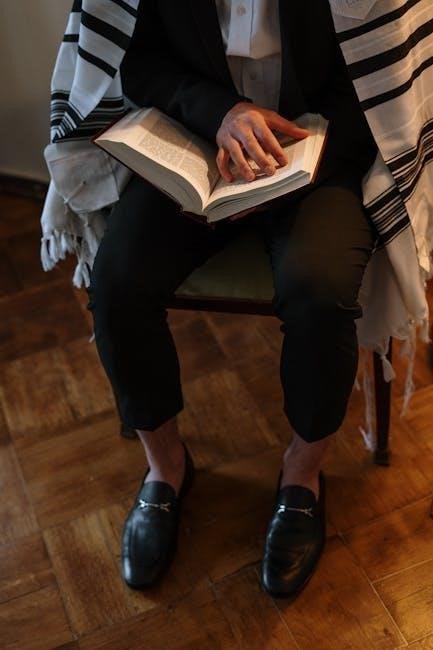
Rituals and Blessings Associated with Shabbat
Shabbat rituals include lighting candles, reciting blessings over wine and challah, and engaging in meaningful prayers․ These practices foster a sacred atmosphere, enhancing spiritual connection and communal bonding․
Blessings Over Wine and Challah
Blessings over wine and challah are central to Shabbat observance, symbolizing gratitude and sanctification․ The wine blessing, known as Kiddush, is recited to sanctify the day, while the challah blessing expresses appreciation for sustenance․ These rituals, outlined in Shabbat prayer PDFs, create a sacred atmosphere, fostering spiritual connection and joy․ The wine blessing is typically recited Friday evening and Saturday morning, and the challah is divided and blessed before meals․ These customs, rooted in tradition, enhance the Shabbat experience, reminding participants of the day’s holiness and the blessings of life․ Shabbat prayer guides often include these blessings, ensuring their proper recitation and meaning․
The Role of the Siddur in Shabbat Prayers
The Siddur, a Jewish prayer book, plays a vital role in Shabbat prayers, serving as a comprehensive guide for worship․ It contains all the prayers, blessings, and songs recited during Shabbat, helping individuals connect with the divine and the community․ The Siddur outlines the order of services, including Maariv, Shacharit, Musaf, and Mincha, ensuring a structured and meaningful observance․ It also includes specific Shabbat blessings, such as the Kiddush and the Shabbat Shalom song, enhancing the spiritual experience․ Many Shabbat prayer PDFs are available, offering digital versions of the Siddur for easy access․ These resources enable participants to follow along seamlessly, fostering engagement and familiarity with the prayers, regardless of their location or level of knowledge․
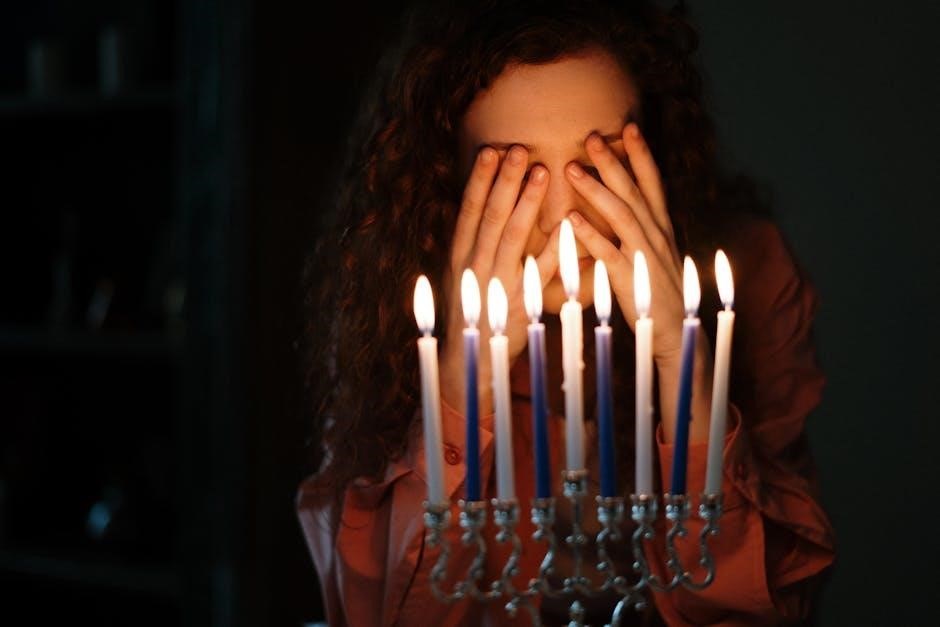
Using Shabbat Prayer PDF Guides
Shabbat Prayer PDF guides provide accessible and convenient resources for following prayer services․ They ensure ease of use, enabling individuals to engage deeply with Shabbat prayers anytime, anywhere․
Benefits of Digital Resources for Prayer
Digital resources like Shabbat prayer PDFs offer unparalleled convenience and accessibility․ They allow individuals to access prayers anytime, anywhere, without the need for physical books․ PDF guides are portable, making them ideal for travel or remote locations․ Additionally, digital resources often include search functionalities, enabling quick navigation to specific prayers or blessings․ They also reduce the need for physical storage space and can be easily shared among communities․ Regular updates ensure that users have the latest versions of prayers and traditions․ Overall, digital resources enhance the prayer experience by combining tradition with modern technology, making Shabbat observance more accessible and engaging for everyone․
Where to Find Reliable Shabbat Prayer PDFs
Reliable Shabbat prayer PDFs can be found on trusted Jewish educational websites, synagogue portals, and reputable online repositories․ Websites like Central Reform and other Jewish organizations often provide downloadable guides․ Additionally, platforms like My Jewish Learning and Chabad offer comprehensive resources․ Many synagogues share their Shabbat siddurim in PDF format for congregants․ Online forums and Jewish community groups also circulate these materials․ When searching, ensure the source is credible to maintain authenticity and accuracy․ These digital resources are invaluable for those seeking to deepen their Shabbat observance with accessible and convenient prayer guides․
Shabbat prayers foster spiritual renewal and connection, offering peace and unity in a busy world․
The Value of Shabbat Prayers in Modern Life
Shabbat prayers offer a profound spiritual escape in today’s fast-paced world․ They foster mindfulness, gratitude, and a sense of community, providing a much-needed pause from daily pressures․ By connecting to ancient traditions, individuals find balance and renewal․ The rituals, such as the Shabbat candle blessing and Kiddush, create meaningful moments of reflection․ Shabbat prayers also encourage a deeper appreciation for life’s simple joys and the importance of rest․ In a world dominated by technology, these prayers remind us to slow down and nurture our inner selves․ Their timeless wisdom continues to inspire people of all backgrounds, offering a holistic approach to spiritual and emotional well-being․
Leave a Reply
You must be logged in to post a comment.